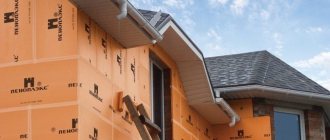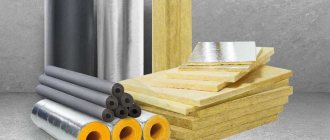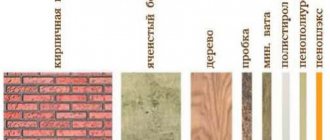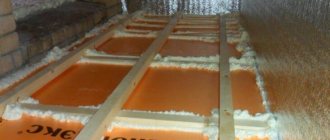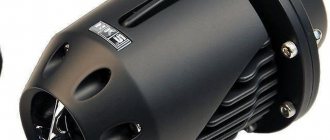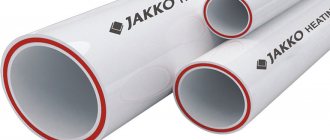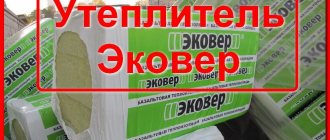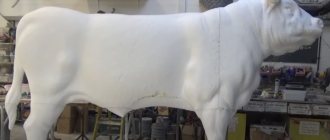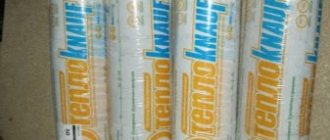Extruded polystyrene foam (EPS) is available in slab form . It is often called penoplex. But you should know that penoplex is a brand (the same as “Giprok” - drywall or “Macroflex” - polyurethane foam). The structure of the insulation under consideration is similar to the structure of conventional polystyrene foam. Being a subtype of polystyrene foam, penoplex is distinguished by its higher density and strength, and has a fine-celled, homogeneous structure consisting of almost completely closed cells. This material is the best type of polystyrene plastic. EPS (penoplex) is made by extrusion, as a result of which polystyrene beads melt, forming a homogeneous mass, which is poured into a mold, where it cools. In this article we will take a detailed look at penoplex insulation, its technical characteristics, advantages, applications and installation features .
Technical characteristics of expanded polystyrene (EPS)
Penoplex is produced by exposing polystyrene granules to high temperature and pressure. By adding a mixture of carbon dioxide and light freon at the next stage, a porous mass is obtained, which is then squeezed out of the extrusion plant. After manufacturing the slabs in the cells, the residual freon is relatively quickly replaced by ambient air.
Penoplex is distinguished among materials for thermal insulation by the following characteristics:
- Low thermal conductivity . The thermal conductivity of penoplex in comparison with other thermal insulation materials is significantly lower and amounts to 0.03 W/m K.
- High compressive and bending strength. Extrusion allows you to achieve uniformity of the material structure. Evenly distributed cells improve the strength characteristics of the material, which does not change its dimensions even under heavy loads.
- Low water absorption (no more than 0.2 - 0.4% by volume in 24 hours). During the tests, XPS boards were left in water for a month. In this case, the liquid was absorbed in small quantities only for the first 10 days, after which the material stopped taking up moisture. At the end of the period, the amount of water in the slabs did not exceed 0.6 percent of their total volume.
- Low vapor permeability (vapor permeability coefficient 0.007-0.008 mg/m·h·Pa). A layer of slabs made of this material, only 2 centimeters thick, has the same vapor permeability as a layer of roofing felt.
- Durability (service life - more than 50 years). Repeated cycles of freezing and thawing the slabs showed that all the characteristics of the material remained unchanged after testing.
- Resistant to combustion . In the manufacture of this material, freons are used, which are safe and non-flammable. They are not poisonous and do not destroy the ozone layer.
- Environmental safety . Most chemicals used in construction are not able to react with penoplex. Exception: toluene, xylene, benzene and similar hydrocarbons; formalin and formaldehyde; ethers, both simple and complex; gasoline, kerosene; oil-based paints and other organic solvents.
- Wide operating temperature range (-50ºС to +75ºС). However, if exposed to excessive heat, the material may melt and ignite.
For clarity, let us highlight all the physical and mechanical properties in the form of a table:
| Indicators | Test method | Dimension | Types of PENOPLEX (old types) | |||||
| Penoplex (31C) | Penoplex wall (31C) | Penoplex foundation (35 without anti-friction) | Penoplex roofing (35) | 45C | 45 | |||
| Density | GOST 17177-94 | kg/m² | 25,0 — 35,0 | 25,0 — 32,0 | 29,0 — 33,0 | 28,0 — 33,0 | 35,0 — 40,0 | 38,1 — 45,0 |
| Compressive strength at 10% linear deformation, not less | GOST 17177-94 | MPa (kgf/cm²;t/m²) | 0,20 (2; 20) | 0,20 (2; 20) | 0,27 (2,7; 27) | 0,25 (2,5; 25) | 0,41 (4,1; 41) | 0,50 (5; 50) |
| Ultimate strength during static bending, not less | GOST 17177-94 | MPa | 0,25 | 0,25 | 0,4 | 0,4 | 0,4 | 0,4 — 0,7 |
| Elastic modulus | UNION DOR SRI | MPa | — | — | — | 15 | 18 | 18 |
| Water absorption in 24 hours, no more | GOST 17177-94 | % by volume | 0,4 | 0,4 | 0,4 | 0,4 | 0,4 | 0,2 |
| Water absorption in 28 days | % by volume | 0,5 | 0,5 | 0,5 | 0,5 | 0,5 | 0,4 | |
| Fire resistance category | Federal Law - 123 | group | G4 | G3 | G4 | G3 | G4 | G4 |
| Thermal conductivity coefficient at (25±)°С | GOST 7076-94 | W/(m °K) | 0,03 | 0,03 | 0,03 | 0,03 | 0,03 | 0,03 |
| Calculated thermal conductivity coefficient under operating conditions “A” | SP 23-101-2004 | W/(m °K) | 0,031 | 0,031 | 0,031 | 0,031 | 0,031 | 0,031 |
| Calculated thermal conductivity coefficient under operating conditions “B” | SP 23-101-2004 | W/(m °K) | 0,032 | 0,032 | 0,032 | 0,032 | 0,032 | 0,032 |
| Sound insulation of the partition (gypsum plasterboard - penoplex 50 mm - plasterboard), Rw | GOST 27296-87 | DB | 41 | 41 | — | 41 | — | — |
| Improvement index for structural noise insulation in floor construction | GOST 16297-80 | DB | 23 | 23 | — | 23 | — | — |
| Standard sizes | Width | mm | 600 | |||||
| Height | mm | 1200 | 2400 | |||||
| Thickness | mm | 20,30,40,50,60,80,100 | 40,50,60,80,100 | |||||
| Operating temperature range | THAT | ºС | -50 to +75 | |||||
Expanded polystyrene is usually sold in packages of 0.25 - 0.3 m³. Depending on the thickness of the sheet, the surface area that can be covered using one package will also vary.
What kind of insulation should it be?
Since there is no objective data about the allegedly harmful effects of penoplex on humans, we will figure it out ourselves.
When choosing insulation, many buyers, having familiarized themselves with the performance characteristics of the products of PENOPLEX SPb LLC, ask the question: “Is penoplex harmful to health?” There are no words, there is a lot of talk about the harmful effects of penoplex, but let's try to figure it out. The selected insulation for buildings or structures must meet the following requirements:
- the material used should not contain dust and small fibers, which confirms the unfoundedness of statements about the dangers of penoplex for the home, since these factors are absent;
- phenol-formaldehyde resins and similar harmful substances are absent in penoplex, which allows us to give a negative answer to the question: “Is penoplex harmful or not?”;
- whether penoplex is harmful to the environment and human health can be judged on the basis that no means are used in its production that destroy the Earth’s ozone layer;
- When the insulation is used from 50 degrees below zero to 75 degrees above zero, as recommended by the instructions for penoplex, there are no harmful emissions for humans, which is confirmed by the sanitary-epidemiological and environmental conclusion.
- Moisture resistance:
- Wetting of the insulation used in construction work leads not only to a decrease in the level of thermal protection, but also to the formation of fungi and mold, therefore, it is incorrect to talk about the harm of penoplex to human health, given its almost zero water absorption;
- modern penoplex insulation is so resistant to moisture that it is not afraid of either drainage water or swelling soils.
High level of thermal protection: is penoplex harmful or not, the use of which not only creates comfortable living conditions, but also reduces heating costs, because it has an extremely low thermal conductivity coefficient (no more than 0.032 W/m K)? ; high resistance to thermal conductivity makes it possible to achieve a noticeable reduction in heat loss with a slight increase in wall thickness. Compressive strength: the strength of the insulation allows it to be used not only for thermal insulation of walls and roofs, but also to increase the thermal protection of foundations, insulation of floors and plinths that can withstand constant loads; Even prolonged use will not lead to deformation or change in the dimensions of modern insulating material.
Application and types of penoplex
Considering that penoplex has a number of advantages, its scope of application is quite extensive. EPS serves as an excellent insulation material both indoors and outdoors. It is perfect for apartments, houses, cottages and other buildings. Penoplex can be used to insulate roofs, attics, and balconies, in any climatic region without the use of an additional moisture-proof layer. Since the material practically does not absorb water, it is quite possible to use it in an environment with high humidity. At the same time, its thermal conductivity remains almost unchanged. EPS sheets of various thicknesses are available for sale, and depending on the specific requirements, you can always choose the best option.
In addition to a variety of sizes, extruded polystyrene foam is available in several types depending on density and application. Let's look at each type:
- Penoplex Wall. The old name is Penoplex 31 with flame retardants . This material has a density of 25-32 kg/m³ and is intended for effective insulation of external and internal walls, partitions, and plinths. These slabs are also used in the construction of buildings when constructing walls using “well masonry”. Compared to traditional brick walls, such walls are much thinner, but are not inferior to them either in reliability or in the ability to retain heat. In case of insulation of external walls with penoplex, a plaster system can be made on top of the insulation using a mesh, or it can be lined with any façade cladding material (siding, tiles, lining).
- Penoplex Foundation. The old name is Penoplex 35 without fire retardant . This material has a density of 29-33 kg/m³ and has high thermal insulation characteristics, a minimum coefficient of water absorption and resistance to chemical and biological destructive factors. Its water-repellent ability allows it to be used as a waterproofing coating. Penoplex Foundation is a rigid slab with a stepped edge, used in the construction of basements, foundations, and insulation of septic tanks. The slabs are very durable and can withstand significant loads. Therefore, they can also be used as a basis for garden paths, plinths, and floors.
- Penoplex Roofing. The old name is Penoplex 35. This material has a density of 28-33 kg/m³ and well insulates the building from cold air, has minimal water absorption, the ability to insulate noise well, and has a long service life. The slabs have a standard size of 600x1200 mm, but if necessary they can be easily cut with any available tool. And the light weight of the slabs allows them to be used without reinforcing roof structures. The stepped edge located along the perimeter acts as an additional guarantee that “cold bridges” will not form at the joints of the slabs. This type of penoplex can be used to insulate any type of roof. However, more often this insulation is used for insulating flat roofs, as well as for insulating the attic space of a ventilated roof.
- Penoplex Comfort. The old name is Penoplex 31C. This material has a density of 25-35 kg/m³ and has an extremely low thermal conductivity coefficient, high hydrophobicity, and excellent ability to insulate noise. It does not rot and is not a favorable environment for the settlement of insects, mold and fungi. Penoplex Comfort is produced in the form of slabs measuring 600x1200 mm, which have a step-shaped edge along the perimeter. It serves as an additional guarantee of accurate installation. Being a kind of universal, this insulation is simply ideal for thermal insulation of a private house. They can be used to insulate floors, foundations, basements, roofs and walls.
Penoplex 45. This material has a density of 35-47 kg/m³ and is used as insulation for road surfaces, in particular runways, to prevent them from frost heaving of the soil and destruction of the top layer of the road surface. It is also widely used for insulating roofs in use, on which there are pedestrian areas and various areas, including parking lots.
Low vapor permeability - good or evil?
As you know, the same property of a material can be considered a plus in one situation and a minus in another. This is exactly the case with the low vapor conductivity that extruded polystyrene foam is characterized by. Moreover, it does not conduct steam in any direction. Moisture does not penetrate from one side or the other. This distinguishes it from vapor barrier membranes, which may have one-way conductivity.
It is ideal on flat roofs
Where is vapor non-conductivity needed?
If installed correctly (without gaps and cracks) with joints taped, EPPS does not require the use of vapor barrier membranes. It hardly lets through steam. Neither in liquid nor in gaseous state. So the use of membranes and waterproofing is unnecessary. When using floors in a cake, this is excellent, because moisture usually comes from the ground. When using polystyrene foam, it does not penetrate either by capillary action or in the form of steam. In this case, this is definitely a plus.
Excellent for laying under screed
These properties are also a plus when using extruded polystyrene foam in blind areas, under paths, etc. In addition to protecting against freezing, it does not get wet. This allows, with a competent approach, to get rid of frost heaving and make, for example, not a deep strip foundation, but a shallow strip or Swedish slab.
The use of EPS in the roofing pie of a flat roof is also optimal - leaks are minimized, and almost no heat is lost. When using on pitched roofs, it’s already worth thinking about. The fact that Penoplex Roofing does not allow moisture into the attic space is good. But it will be possible to remove excess moisture from the attic only with the help of very good ventilation, which includes not only dormer windows. Additional elements will be needed on the ridge, in the roof plane. In general, given the cost of Penoplex, this is not always reasonable.
On the walls: yes or no?
Insulating walls with Penoplex is permissible only if you agree to make an effective ventilation system that will regulate the humidity in the house. In this case there are two options:
- Insulate the walls with EPS from the inside. With this solution, moisture practically does not enter the enclosing structures (the material from which the walls are made) due to the low vapor permeability of the material. In this case, the Penoplex layer for walls can be of small thickness. Specifically, it is necessary to count, since it depends on the material and thickness of the walls, and the region of residence. But, with such insulation, it is necessary to select the external finishing of the facade so that moisture is not trapped inside the wall. Ventilated facades are most suitable for this purpose.
- Stick the EPS on the outside. But at the same time, it is necessary to make an effective vapor barrier inside the room. It is needed to prevent moisture from entering the walls. Since there is EPS on the outside, it will not come out. To prevent moisture from accumulating in the wall, a vapor barrier is required. In this case, the thickness of Penoplex will be large. So large that the dew point is not in the wall, but in the thickness of the insulation. That is, in this case it will be necessary to insulate EPS walls with a thickness of 100 mm or more.
As you can see, there are options for using extruded polystyrene foam for wall insulation, but they are far from the best. Despite the fact that the material itself is good, it is poorly suited for this purpose.
When used on a pitched roof
And we must also take into account that the second option is only for non-hygroscopic materials.
Such a scheme is very undesirable for wooden, frame buildings; it is poorly suited for foam blocks. The fact is that no matter how good the vapor barrier is, some of the moisture will still get into the walls. If the material is non-hygroscopic, moisture will gradually be removed from the wall during the dry season. With hygroscopic materials this process is more complicated. As a result, the wood rots and the foam block walls “bloom.” Date: September 25, 2022
Installation technology of polystyrene insulation boards
Insulation of external, internal walls and other structures using extruded polystyrene is carried out in several stages. Let's look at each of them:
- The preparatory stage consists of preparing the walls for insulation, cleaning them from dirt, dust, old finishing materials, and paint coatings. In case of large unevenness, it is recommended to level the surface using a plaster mixture (and other methods depending on the design) and treat it with an antifungal compound.
- Fixation using special adhesive facade compounds . The adhesive is applied directly to the insulating board using a comb.
- Mechanical fastening is done using dowels.
- Installation of facade mesh . For better adhesion of the glue to the insulation, you can create roughness on the surface of the slabs. The first plaster layer of façade adhesive is used to fix the reinforcing polymer mesh. Next, a second layer of plaster is applied, after which has dried, the walls are covered with decorative plaster (optional) and painted.
- Instead of plaster, it is possible to decorate the walls with siding, wood, as well as the use of ventilated facades.
EPS installation technology
Thermal insulation of roofs is carried out either at the construction stage or during the reconstruction process, for example, when converting a cold attic into a living space. In this case, the insulation is laid on the base in several layers (the joints of the top layer should not coincide with the joints of the bottom). Next, a vapor-permeable membrane is spread over the penoplex. The resulting cake is secured with longitudinal slats with a thickness of at least 40 mm to ensure ventilation between the insulation and the roofing material.
Dimensions
The manufacturer produces Penoplex Comfort slabs in six size groups. Moreover, the length and width are always the same and are approximately 1200x600 mm , or more precisely 1185x585 mm . The thickness of the products and the number of slabs in the package are as follows:
- 20 mm - 18 pcs. packaged (total 12.47 m² );
- 30 mm - 12 pcs. ( 8.31 m² );
- 40 mm - 9 pcs. ( 6.24 m² );
- 50 mm - 7 pcs. ( 4.85 m² );
- 60 mm - 7 pcs. ( 4.85 m² );
- 100 mm - 4 pcs. ( 2.77 m² ).
The area of one polystyrene board is approximately 0.69 m² .
Description of material – penoplex
Innovative insulation to create a comfortable atmosphere in the home.
The insulation consists of slabs consisting of sealed small cells, due to which the water absorption rate is almost zero. The material obtains its density and thermal conductivity thanks to a special production method. Expanded polystyrene is used to make boards. The granules are placed in an extruder, where the material foams under the influence of temperature and pressure. It is then passed through dies, which give the heat insulator the shape of slabs. The result is insulation with high technical performance.
Comparison by main parameters
Mineral wool has a coefficient of 0.032-0.046, while penoplex has a coefficient of 0.03-0.032. The lower the indicator, the better, because there is less heat loss and the temperature inside the room is better maintained.
Penoplex is a fairly hard material that does not rot, dry out or crumble. The insulation has a long service life under the correct storage conditions, when it is reliably protected from prolonged sunlight and excessive heat. Mineral wool also does not dry out. Without exposure to high physical stress, it can last for a long time, is not afraid of high or low temperatures and long exposure to sunlight on the surface.
It is not at risk of mold and other harmful organisms, and it is also not susceptible to destruction by rodents. But mineral wool can crumble and settle on the wall. In general, both materials have an enormous service life, lasting at least 50 years.
Environmentally friendly.
Both materials are manufactured without the use of any hazardous components that could be harmful to human health, but still require absolute containment to protect the respiratory tract.
When insulating a perfectly smooth surface, work using penoplex is carried out much faster. It is lightweight, easy to cut and sand, and with an L-shaped edge, it eliminates the formation of cold bridges. When using it, there is no need to cover it with a vapor barrier. If there is no tongue-and-groove edge, then it is tedious to seal the seams or lay them in two overlapping layers, which will lead to unnecessary costs.
Mineral wool has a little more weight, but it is much more efficient and simplifies installation in existing heavy, disproportionate areas and structures. But when working with it, you must purchase special clothing in advance, along with a respirator and safety glasses.
If used to insulate the facade of a house, if the penoplex has a thickness of 50 mm, then the mineral wool should have a thickness of 60 mm to have a similar effect. The difference is not entirely dramatic. Depending on the situation, each of them is good in its own way, because cotton wool is capable of allowing air to pass through, unlike penoplex, which has an absolutely airtight structure.
Mineral wool absorbs water much more strongly, subsequently losing some of its thermal insulation characteristics. In this case, penoplex is significantly better, because even with intense and frequent rains, its mass will practically not change.
Mineral wool has the best performance in this parameter, because it is almost inflammable. Its melting point should be more than 1000°. Cotton wool contains an adhesive base that can ignite, but it occupies a very tiny part of the total volume of the material and does not pose a significant danger.
Penoplex is completely opposite in its qualities. It can melt and burn in open fire, releasing toxins that are very harmful to the human body. To ensure a high level of protection of buildings from fire, penoplex is categorically unsuitable for use. For these purposes, the best and unconditional option is mineral wool.
The price of materials is practically no different. There may be a slight difference only depending on the choice of the manufacturer.
Properties
Like all types of materials, it has advantages and disadvantages.
Positive traits
Strength
- Thanks to the monolithic cellular structure, the layer does not crumble.
- High degree of compression resistance.
Performance characteristics
- The thermal conductivity coefficient is lower than that of polystyrene foam.
- Does not rot from dampness, does not harbor insects - the listed factors will extend the life of use to 50 years.
- Frost-resistant.
- Withstands temperatures created in a sauna or steam bath.
Resistant to moisture absorption
- The material becomes hydrophobic - resistance to water penetration.
- As a result of the formed closed cell, it becomes resistant to vapor permeability.
- Application does not require additional waterproofing.
Fire safety
- During manufacturing, fire retardants are added to the components, making it non-flammable. During fire, the material smolders without supporting the process.
Density
- The indicator affects the strength characteristics and weight. It is increased artificially by repeating the heating process, subject to the technological sequence. The price of the product increases with additional manufacturing costs.
Environmental friendliness
- When heated and the humidity of the room is high, penoplex 50 does not emit toxic substances.
- Does not harm the atmosphere.
- Closed air cells in the structure are characteristic of types of materials that do not support some chemical reactions. It is effective for insulating the foundation and blind area of a building.
Negative qualities
- Organic solvents contained in the glue cause loss of density and change the integrity of the structure.
- A low vapor permeability coefficient has a negative effect on base condensation. It is necessary to leave a gap when insulating walls from the inside.
- High price for material. The higher the density, the more expensive it is.
Type 3131C
This type of Penoplex insulation is more reliable due to its resistance to deformation. It was used in the insulation of facade systems and internal partitions in private houses, balconies and loggias in high-rise construction. The excellent insulating characteristics of this type of extruded polystyrene foam insulation have made it also in demand for insulating sewer lines laid in the upper frozen layer of soil.
In road construction, Penoplex 31, due to its high degree of resistance to deformation and weight loads, is also used to minimize the risk of the formation of so-called “ice lenses” due to freezing of the soil directly under a highway or railway.
Penoplex 31C (Standard) is the most suitable material for insulating static, non-load-bearing structures. It was preferred in the process of insulating internal wall partitions in private civil construction, as well as when laying utilities as part of water and heat supply systems. In engineering construction, Type 31C was also used to protect sewer lines from freezing, during the construction of wells, water storage tanks, swimming pool bowls, and when laying underground networks.
